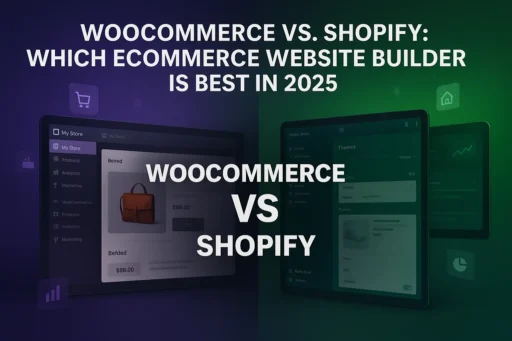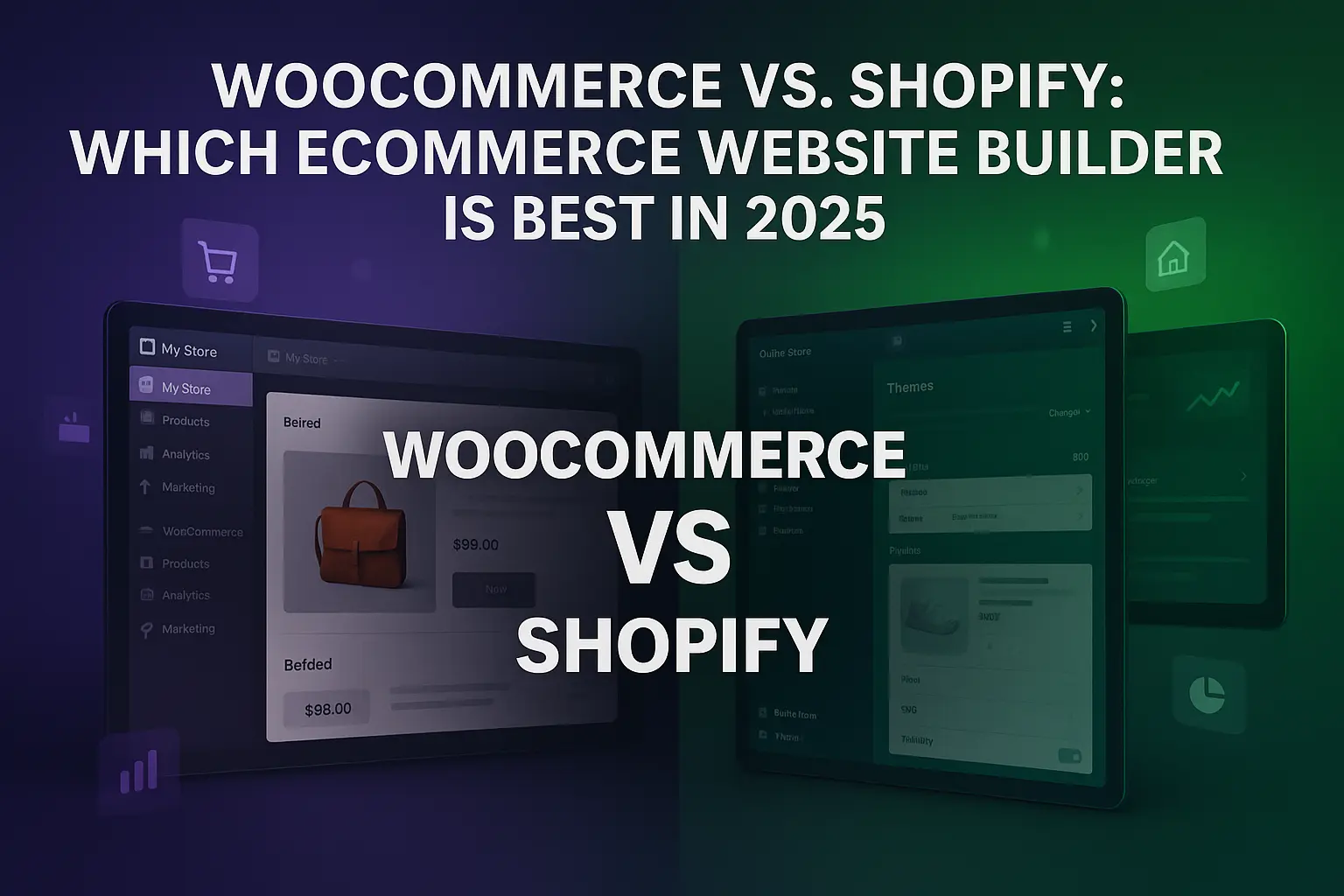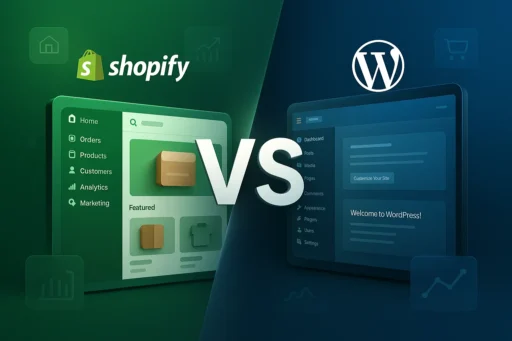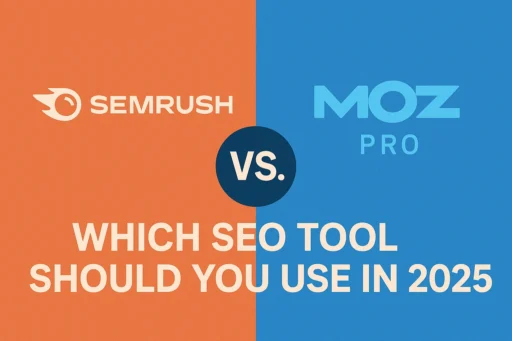WooCommerce and Shopify continue to dominate the eCommerce landscape in 2025, but choosing between these two powerhouses can feel overwhelming. At Search Savvy, we understand that selecting the right eCommerce website builder is one of the most critical decisions you’ll make for your online business. Whether you’re launching your first store or considering a platform switch, this comprehensive comparison will help you make an informed choice based on real-world data and expert insights from Search Savvy’s team.
Shopify commands approximately 20% of the eCommerce platform market, while WooCommerce holds an impressive 32.6% share in 2025. These numbers tell us that both platforms are trusted by millions of merchants worldwide, but they serve distinctly different needs. At Search Savvy, we’ve helped countless businesses navigate this decision, and we’re here to break down everything you need to know about these two leading platforms.
What Are WooCommerce and Shopify?
WooCommerce is a free, open-source plugin designed specifically for WordPress websites. As an eCommerce website builder, it transforms your existing WordPress site into a fully functional online store with complete customization control. You own your website, your data, and every aspect of your store’s design and functionality. The self-hosted nature of WooCommerce means you’ll need to arrange your own hosting, but this approach offers unparalleled flexibility for businesses that want total control.
Shopify operates as a comprehensive, all-in-one hosted platform that handles everything from server management to security updates. This eCommerce website builder starts at $39 per month and provides a complete solution where you simply sign up, choose a theme, and begin selling. Shopify’s approach removes technical barriers, making it ideal for merchants who want to focus on sales rather than website maintenance.
How Does Pricing Compare Between WooCommerce and Shopify in 2025?
WooCommerce pricing begins with the free core plugin, but your total investment includes hosting ($20-$35 monthly), premium themes ($50-$200 one-time), and optional extensions ($0-$300). The beauty of this eCommerce website builder lies in its cost scalability—you control exactly what you spend and when. There are no mandatory monthly platform fees, and WooCommerce doesn’t charge transaction fees on your sales. For businesses processing moderate volumes, total monthly costs typically range from $50-$100 when factoring in quality hosting and essential plugins.
Shopify’s pricing structure in 2025 offers three main tiers: Basic at $39/month, Shopify at $105/month, and Advanced at $399/month. Each eCommerce website builder plan includes hosting, SSL security, and 24/7 support. Credit card processing fees start at 2.9% + 30¢ per transaction on the Basic plan, decreasing to 2.7% + 30¢ on higher tiers. If you use third-party payment processors instead of Shopify Payments, an additional 2% fee applies. Shopify also introduced a special $1 first-month offer in 2025, making it easier for new merchants to test the platform.
According to Search Savvy’s analysis, both platforms’ costs tend to equalize once businesses reach approximately $20,000 in monthly revenue. WooCommerce offers predictable scaling where you add costs gradually, while Shopify provides all-inclusive pricing with significant jumps between plan levels.
Which Platform Is Easier to Use?
Shopify excels in simplicity with its intuitive drag-and-drop interface and step-by-step guided setup process. This eCommerce website builder requires no coding knowledge, and you can have a professional-looking store live within hours. The 2025 Shopify update introduced AI-powered features including Shopify Magic for automated product descriptions and Shopify Sidekick for intelligent setup assistance. Everything from payment processing to inventory management is streamlined through a clean, unified dashboard.
WooCommerce setup requires more initial configuration since you’re working within the WordPress ecosystem. This eCommerce website builder gives you access to WordPress’s powerful content management system, but you’ll need to spend time selecting and configuring themes, plugins, and hosting settings. The learning curve is steeper, particularly for users unfamiliar with WordPress. However, millions of beginners successfully overcome this initial phase, and the platform becomes intuitive once you understand the basics. Modern WooCommerce themes now incorporate WordPress’s block editor, significantly simplifying the design process.
Why Is Design Flexibility Important for Your eCommerce Website Builder?
Shopify provides access to over 800 professionally designed themes as of 2025, including 23 free options and premium themes ranging from $100-$500. The platform added 10 new free themes in early 2025, all featuring mobile optimization, mega menus, quick view functionality, and stock counters. Shopify’s AI theme generator, launched in 2025, allows merchants to create custom store designs from simple text prompts. While the themes look polished out of the box, deep customization requires learning Liquid, Shopify’s proprietary templating language.
WooCommerce opens up access to thousands of WordPress themes through its ecosystem. The official WooCommerce store offers 112 themes, while marketplaces like ThemeForest provide 1,500+ premium options. This eCommerce website builder gives you complete control over every design element, and you can modify any aspect of your store’s appearance using standard HTML, CSS, and PHP. AI-powered tools like ZipWP and 10Web can now automatically generate complete WooCommerce stores based on your specifications, making professional design more accessible than ever.
How Do Payment Processing Options Differ?
WooCommerce supports virtually every payment gateway imaginable, including PayPal, Stripe, Authorize.net, Amazon Pay, and Square by default. This eCommerce website builder charges no platform transaction fees—you only pay the processing fees set by your chosen payment provider (typically 2.9% + 30¢ for Stripe and PayPal). The open-source nature means any payment company can create WooCommerce integrations, including regional and specialized payment services that might not be available on closed platforms.
Shopify Payments integrates seamlessly with Shopify stores, charging 2.9% + 30¢ per transaction on the Basic plan. This eCommerce website builder also supports third-party payment processors, but adds a 2% fee when you don’t use Shopify Payments (reduced to 1% on higher-tier plans). Shopify’s winter 2025 update enhanced international selling with automatic tax calculations based on customer location and region-specific pricing controls, allowing merchants to set custom prices per country or region.
What About SEO Capabilities?
WooCommerce leverages WordPress’s renowned SEO capabilities, making it a powerhouse for content marketing and organic search visibility. This eCommerce website builder allows you to publish blogs, tutorials, and educational content directly within your store, building trust and attracting organic traffic. Premium SEO plugins like Yoast SEO and Rank Math provide granular control over meta tags, schema markup, XML sitemaps, and technical SEO elements. The platform’s flexibility allows complete URL customization and unlimited content optimization opportunities.
Shopify includes built-in SEO features covering the essentials—editable meta descriptions, XML sitemaps, and fast content delivery through its global CDN. This eCommerce website builder’s blogging capabilities work adequately for basic content marketing, though they lack WordPress’s sophisticated publishing tools. URL customization has some limitations, and creating sub-categories can be challenging. Many successful Shopify merchants run separate WordPress blogs on subdomains to leverage superior content marketing capabilities while maintaining their Shopify store for transactions.
How Does Each Platform Handle Scalability and Growth?
WooCommerce scales according to your specific needs without forcing plan upgrades. This eCommerce website builder allows unlimited products, unlimited variable product options, and supports stores processing millions in annual revenue. You can add enhanced functionality through plugins as your business grows, paying only for features you actually use. Large enterprises appreciate WooCommerce’s ability to handle complex requirements like 100,000+ SKUs, custom product kits, pre-orders, and unconventional checkout flows without hitting platform limitations.
Shopify’s infrastructure automatically handles traffic spikes and scale, with the platform managing all technical aspects of growth. This eCommerce website builder’s winter 2025 update improved inventory management with low-stock cart warnings and the ability to create product collections based on attributes like color or material. Shopify’s built-in features for point-of-sale, the Shop App, and social media integration make omnichannel selling straightforward. However, businesses requiring deep customization may find themselves constrained by the platform’s architecture, and pricing jumps significantly as you move between plan tiers.
Which Platform Offers Better Support and Resources?
Shopify provides 24/7 customer support via chat, email, and phone for all paying subscribers. This eCommerce website builder maintains comprehensive documentation, video tutorials, and an active community forum. The dedicated support team can assist with technical issues, troubleshooting, and platform-specific questions. Shopify’s support infrastructure is particularly valuable for non-technical merchants who need immediate assistance.
WooCommerce relies on community-driven support through WordPress forums, extensive documentation, and third-party developers. While the core plugin is free, this eCommerce website builder doesn’t include direct support from WooCommerce developers. However, your hosting provider typically offers support for server-related issues, and the massive WordPress community means you can find solutions to virtually any problem through forums, tutorials, and developer resources. Many WooCommerce users hire developers or agencies for specialized assistance, which provides more personalized support than standard help desk tickets.
Should You Choose WooCommerce or Shopify for Dropshipping?
WooCommerce provides excellent dropshipping capabilities with extensive customization options for product pages and the ability to connect multiple print-on-demand services simultaneously. This eCommerce website builder integrates with services like Printful, Printify, and Podbase through dedicated plugins. You maintain complete control over your dropshipping workflow, customer data, and profit margins. The lack of platform transaction fees means you keep more of each sale, which matters significantly when operating on dropshipping’s typically thin margins.
Shopify’s app ecosystem makes dropshipping incredibly straightforward with one-click integrations for major suppliers. This eCommerce website builder’s Apps Store contains hundreds of dropshipping and print-on-demand apps with preset configurations. The simplified setup process gets beginners selling faster, though you’ll pay platform fees on top of supplier costs. Shopify’s fulfillment network and shipping discounts (up to 88% off rates) can offset some of these costs for high-volume sellers.
What Do Real Users Say?
According to Search Savvy’s research and industry analysis, businesses choose WooCommerce when flexibility, customization, and cost control are priorities. One automotive parts company processing $50 million annually selected WooCommerce specifically for its ability to handle over 100,000 SKUs with complex variants and custom product configurations—something that would be extremely challenging and expensive on Shopify.
Shopify users consistently praise the platform’s ease of use, reliable infrastructure, and time savings. Companies appreciate not worrying about security updates, server maintenance, or plugin conflicts. The predictable monthly costs and comprehensive features allow merchants to focus entirely on marketing and sales rather than technical management.
WooCommerce vs. Shopify: Which eCommerce Website Builder Should You Choose?
At Search Savvy, we recommend Shopify for merchants who prioritize simplicity, want to launch quickly, and prefer all-inclusive pricing with comprehensive support. Choose this eCommerce website builder if you’re a beginner, lack technical resources, or need robust omnichannel selling features including point-of-sale and social commerce integrations right out of the box.
Select WooCommerce when you need maximum customization, want to avoid monthly platform fees, or require WordPress’s powerful content marketing capabilities. This eCommerce website builder is ideal for businesses with technical resources, complex product catalogs, specific design requirements, or those who want complete control over their data and customer relationships.
Both platforms successfully power millions of online stores in 2025, and your choice ultimately depends on your business model, technical comfort level, and long-term growth plans. Consider spinning up trial environments for both platforms to test your specific workflow before making a final decision.
Frequently Asked Questions
Can I migrate from Shopify to WooCommerce or vice versa?
Yes, migration is possible in both directions using tools like Cart2Cart or Matrixify, which transfer products, customer data, and order history. Expect the migration process to take 1-2 weeks for a complete replatform, depending on your store’s size and complexity. Most businesses work with developers or agencies to ensure smooth data transfer and maintain SEO rankings during the switch.
Is WooCommerce really free?
WooCommerce’s core plugin is free, but running a store requires hosting ($20-35/month), a domain name ($10-15/year), and potentially premium themes or plugins. While the software itself costs nothing, your total monthly investment typically ranges from $50-100 for a basic store, scaling up as you add features and traffic increases.
Which platform is faster for site performance?
Shopify generally delivers faster load times by default thanks to its optimized CDN and managed infrastructure, achieving sub-2-second load times without additional optimization. WooCommerce speed depends entirely on your hosting quality and optimization efforts—with premium hosting and proper configuration, WooCommerce can match or exceed Shopify’s performance.
Do WooCommerce and Shopify support international selling?
Both platforms support international commerce. Shopify’s 2025 updates include automatic tax calculations by country and region-specific pricing controls. WooCommerce offers similar functionality through plugins like WooCommerce Multilingual and various currency converters, providing more granular control but requiring additional setup.
Can I sell both physical and digital products on these platforms?
Yes, both WooCommerce and Shopify fully support physical products, digital downloads, subscriptions, and services. WooCommerce handles digital products natively and offers extensive plugins for subscriptions and bookings. Shopify includes digital product support in all plans and provides apps for recurring billing and booking systems.
What happens to my store if I stop paying?
With Shopify, your store becomes inaccessible if you stop paying—your subscription ends and customers cannot place orders. With WooCommerce, your store continues functioning as long as you maintain your hosting and domain registration, since you own the software and there are no platform fees. This ownership difference represents one of the fundamental distinctions between the two platforms.







